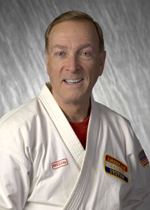

 |
 |
|
Online Edition: 042 December 2013 |

Michael A. Sullenger 9th Dan . . . In this issue: This Page... The Master's Edge Page 2: A Little Wisdom Page 3: The "Answer" Is ? and Life in the Dojo Page 4: Club News Page 5: Guest Article Page 6: The News... CLICK HERE for Past "Punchline" Editions! Return to "Home Page" |
AKS Quarterly Newsletter"The Punchline Editorial"
As I begin the last editorial for this year, I'm reminded of the significance of the date - the 7th. On this date 72 years ago Japan attacked Pearl Harbor. Many Americans were dead set against their country becoming involved in the war that raged in Europe. Yet, like all realities, one cannot hide from the bad guys forever. Today the same realities exist as they did all those years ago. Only today the enemy can be found in the form of terrorism, or the dangerous nature of the streets and communities in which we live and travel. In the past, I've written about the need and importance of all of us to be prepared. The amount of that preparedness is clearly the choice each of us must decide on. Those of us in the AKS prepare to defend ourselves and loved ones should such need arise. We prepare in the hope of never having to resort to using the deadly skills we train on. Sadly, many in our society are not as pragmatic as we in the AKS family are. They go about their daily lives under the assumption someone else will protect and defend them. With more than four decades as a cop, I can tell you without equivocation that by the time the police arrive, whatever is taking place will have ended. If you haven't dealt with the problem yourself, well who knows whether you'll be around to tell the officers responding what happened. I know that's a sobering thought. It is one we should all be aware of. Many of you practice your skills at your respective schools and clubs, as well as attending one of the seminars the AKS holds three times a year. It's during those seminars, we have the opportunity to train with other members of our organization who travel to the seminars from their respective homes to renew friendships, make new ones, and learn new skills. I know from the comments I receive this means a lot to many of you, both here in the USA as well as in Germany. As your chief instructor this gladdens my heart and reaffirms the special nature of the AKS and its members. As we near Christmas Day, please keep in mind first and foremost that Jesus is the reason for the season. Christmas is not about the buying and giving of gifts, but the celebration of his birth for our redemption. Add to this a time when families come together in love and fellowship with each other and you have a truly magical time of year. I look forward to, once again, seeing many of you next year at one of the seminars or the annual summer camp in Muskegon. Janie and I want to wish you, one and all, a blessed and merry Christmas. Mike Sullenger, 9th Dan AKS Chief Instructor 
|
|
. . . In this issue: Page 1: The Master's Edge This Page. . . A Little Wisdom Page 3: The "Answer" Is ? and Life in the Dojo Page 4: Club News Page 5: Guest Article Page 6: The News... CLICK HERE for Past "Punchline" Editions! Return to "Home Page" |
Weapons
|
 . . . In this issue: Page 1: The Master's Edge Page 2: A Little Wisdom This Page. . . The "Answer" Is ? and Life in the Dojo Page 4: Club News Page 5: Guest Article Page 6: The News... CLICK HERE for Past "Punchline" Editions! Return to "Home Page" |
Beyond The Strike . . .
by Rand Palmer, 6th Dan AKS
|
 . . . In this issue: Page 1: The Master's Edge Page 2: A Little Wisdom Page 3: The "Answer" Is ? and Life in the Dojo This Page. . . Club News Page 5: Guest Article Page 6: The News... CLICK HERE for Past "Punchline" Editions! Return to "Home Page" |
PROMOTIONS!!
|
Best wishes in your continued training! Attention Instructors, if you have students who have been promoted, please send this information so that we may acknowledge their accomplishments.
| |||||||||||||||||||||||||||||||||||||||||||||||||||||||||||||||||||||||||||||||||||||||||||||||||||||||||||||||||||||||||||||||||||||||||||||||||||||||||||||||||||||||||||||||||||||||||||||||||||||||||||||||||||||||||||||||||||||||||||||||||||||||